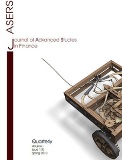AN EMPIRICAL STUDY OF EXPOSURE AT DEFAULT
AN EMPIRICAL STUDY OF EXPOSURE AT DEFAULT
Author(s): Michael JacobsSubject(s): Economy
Published by: ASERS Publishing
Keywords: exposure at default; recoveries; default risk; bankruptcy; credit risk; Basel II
Summary/Abstract: In this study we empirically investigate the determinants of and build a predictive econometric model for exposure at default (EAD) using a sample of Moody’s rated defaulted firms having revolving credits. We extend prior empirical work by considering alternative determinants of EAD risk, in addition to the traditional factors (e.g., credit rating.) Various measures of EAD risk are derived and compared. We build a multiple regression model in the generalized linear class and examine the comparative rank ordering and predictive accuracy properties of these. We find weak evidence of counter-cyclicality in EAD. While we find EAD risk to decrease with default risk, utilization has the strongest inverse relation. We also find EAD risk reduced for greater leverage, liquidity, more debt cushion; and increased for greater company size, higher collateral rank or more bank debt in the capital structure of the defaulted obligor. The models are validated rigorously through resampling experiment in a rolling out-of-time and sample experiment. In addition to the credit risk management implications of this study (the parameterization of pricing and portfolio management models), there is use in quantifying EAD risk for banks qualifying for the Advanced IRB approach in the regulatory framework of the Basel II accord.
Journal: Journal of Advanced Studies in Finance (JASF)
- Issue Year: I/2010
- Issue No: 01
- Page Range: 31-59
- Page Count: 29
- Language: English
- Content File-PDF

